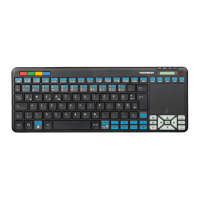3
5. Getting started
• Always use two AAA batteries.
• Remove the battery compartment cover
8
on the bottom of the remote control.
• Remove the USB receiver kept in the battery compartment. (Dongle shipment: attached inside the
box)
• Match the polarity markings on the batteries (+/-) with those on the battery compartment.
• Insert the batteries.
• Replace the battery compartment cover
8
on the remote control.
• If the power display [ ]ashes on the LCD
3
replace the two AAA batteries and dispose of
the dead batteries in accordance with the disposal instructions.
Note
• The settings willremain stored on the remote control when you replace the batteries.
• Insert the USB receiver into afree, suitable USB port (for example, HID support) on the terminal
device (TV,set-top box, DVB-T/-C/-Stuner,PCoraudio device).
• Switch on the remote control using the [ON/OFF switch]
6
.
Changing the preset connection mode
• The rst time you switch on the remote control, TV modus is automatically enabled and a
connection is made to the USB receiver.Ifyou wish to use the remote control with adifferent
terminal device, change the
2
mode.
If the connection to the remote control’s USB receiver does not work automatically,please proceed
as follows:
• Youcan switch to PC mode by pressing the PC button
2
.
• Press and hold [ESC +K]at the same time for 5seconds until the display ashes
on the
3
LCD.
• When the display
appears constantly on the
3
LCD,you aresuccessfully connected to a
different terminal device in the corresponding mode.
• To deactivate, press (FN+R) until
goes out on the display.
Note
Wherepossible, the TV will always switch on again (in standby mode) if the keyboard’swireless
connection to the USB dongle is enabled (manufacturer-dependent).
To prevent the TV from switching on unnecessarily,wegenerally recommend that you disable the
wireless USB transmission (FN+R) and enable it using the above-mentioned shortcut key (ESC+K)
only when required. By deactivating the wireless connection, you can also extend battery life (the
infrared functions will not be impaired).
6. Operation
6.1 PC mode
Windows keyboard functions
These functions may be possible, depending on operating system; or they may be possible on
different devices and to adifferent degree.
Example –Windows application:
SUBTITLE
AVMODE
MYKEY
TEXT
PORTALRATIO
MYAPPS
AD
ENERGY
TV/RAD
SLEEP FAV
Q.MENU
Example –Windows touchpad functions:
Single-nger swipe Mouse pointer control
Single tap Click at position of mouse pointer
Two-nger swipe (horizontal or
vertical)
Horizontal or vertical mouse movement
(scroll wheel)
Pinch to zoom. Move two ngers apart to zoom in; move two ngers closer
together to zoom out.

